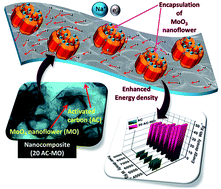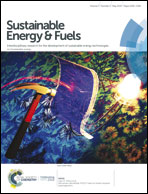Performance enhancement of a supercapacitor negative electrode based on loofah sponge derived oxygen rich carbon through encapsulation of MoO3 nanoflowers†
Abstract
Developing low cost and high energy density negative electrode materials without deterioration of the environment is an imperative need in the area of energy storage. Here, encapsulation of MoO3 nanoflowers (MO) in activated carbon (AC) derived from biomass i.e. a loofah sponge is envisioned to accomplish the synthesis of a cost effective and highly capacitive negative electrode for supercapacitors. AC derived from a loofah sponge inherited the structure with plenty of meso/macropores and oxygen functionalities to anchor MoO3 (∼50 nm dia.), while the nanoflower configuration of particles offers adequate interfacial active sites for charge storage. The oxygen functionalities of AC together with the intercalation/diffusive ability of MoO3 (MO) in the composite (20 AC-MO) lead to splendid performance (413 F g−1@8 A g−1) compared to AC (102.89 F g−1@8 A g−1). More significantly, 20 AC-MO shows remarkable improvement in energy density (52.87 W h kg−1@3.8 kW kg−1) compared to AC (12.62 W h kg−1@3.7 kW kg−1). Herein, the blend of the capacitive mechanism with the pseudo-intercalation mechanism is adopted to improve the charge storage ability of the negative electrode. Consequently the highly capacitive negative electrode can potentially improve the asymmetric supercapacitor performance for future applications.



 Please wait while we load your content...
Please wait while we load your content...